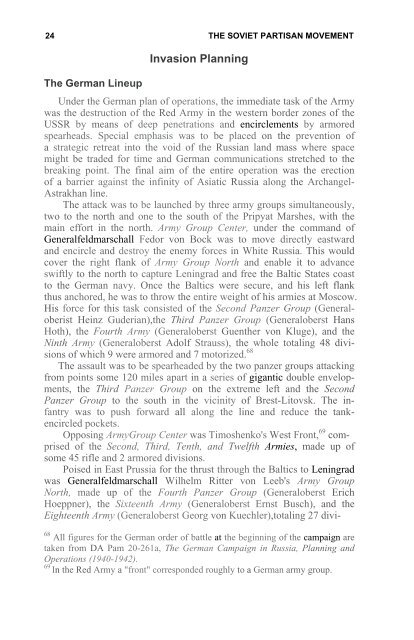the soviet partisan movement 1941-1944 by edgar m. howell
the soviet partisan movement 1941-1944 by edgar m. howell
the soviet partisan movement 1941-1944 by edgar m. howell
Create successful ePaper yourself
Turn your PDF publications into a flip-book with our unique Google optimized e-Paper software.
24 THE SOVIET PARTISAN MOVEMENT<br />
The German Lineup<br />
Invasion Planning<br />
Under <strong>the</strong> German plan of operations, <strong>the</strong> immediate task of <strong>the</strong> Army<br />
was <strong>the</strong> destruction of <strong>the</strong> Red Army in <strong>the</strong> western border zones of <strong>the</strong><br />
USSR <strong>by</strong> means of deep penetrations and encirclements <strong>by</strong> armored<br />
spearheads. Special emphasis was to be placed on <strong>the</strong> prevention of<br />
a strategic retreat into <strong>the</strong> void of <strong>the</strong> Russian land mass where space<br />
might be traded for time and German communications stretched to <strong>the</strong><br />
breaking point. The final aim of <strong>the</strong> entire operation was <strong>the</strong> erection<br />
of a barrier against <strong>the</strong> infinity of Asiatic Russia along <strong>the</strong> Archangel-<br />
Astrakhan line.<br />
The attack was to be launched <strong>by</strong> three army groups simultaneously,<br />
two to <strong>the</strong> north and one to <strong>the</strong> south of <strong>the</strong> Pripyat Marshes, with <strong>the</strong><br />
main effort in <strong>the</strong> north. Army Group Center, under <strong>the</strong> command of<br />
Generalfeldmarschall Fedor von Bock was to move directly eastward<br />
and encircle and destroy <strong>the</strong> enemy forces in White Russia. This would<br />
cover <strong>the</strong> right flank of Army Group North and enable it to advance<br />
swiftly to <strong>the</strong> north to capture Leningrad and free <strong>the</strong> Baltic States coast<br />
to <strong>the</strong> German navy. Once <strong>the</strong> Baltics were secure, and his left flank<br />
thus anchored, he was to throw <strong>the</strong> entire weight of his armies at Moscow.<br />
His force for this task consisted of <strong>the</strong> Second Panzer Group (Generaloberist<br />
Heinz Guderian),<strong>the</strong> Third Panzer Group (Generaloberst Hans<br />
Hoth), <strong>the</strong> Fourth Army (Generaloberst Guen<strong>the</strong>r von Kluge), and <strong>the</strong><br />
Ninth Army (Generaloberst Adolf Strauss), <strong>the</strong> whole totaling 48 divisions<br />
of which 9 were armored and 7 motorized. 68<br />
The assault was to be spearheaded <strong>by</strong> <strong>the</strong> two panzer groups attacking<br />
from points some 120 miles apart in a series of gigantic double envelopments,<br />
<strong>the</strong> Third Panzer Group on <strong>the</strong> extreme left and <strong>the</strong> Second<br />
Panzer Group to <strong>the</strong> south in <strong>the</strong> vicinity of Brest-Litovsk. The infantry<br />
was to push forward all along <strong>the</strong> line and reduce <strong>the</strong> tankencircled<br />
pockets.<br />
Opposing ArmyGroup Center was Timoshenko's West Front, 69 comprised<br />
of <strong>the</strong> Second, Third, Tenth, and Twelfth Armies, made up of<br />
some 45 rifle and 2 armored divisions.<br />
Poised in East Prussia for <strong>the</strong> thrust through <strong>the</strong> Baltics to Leningrad<br />
was Generalfeldmarschall Wilhelm Ritter von Leeb's Army Group<br />
North, made up of <strong>the</strong> Fourth Panzer Group (Generaloberst Erich<br />
Hoeppner), <strong>the</strong> Sixteenth Army (Generaloberst Ernst Busch), and <strong>the</strong><br />
Eighteenth Army (Generaloberst Georg von Kuechler),totaling 27 divi-<br />
68 All figures for <strong>the</strong> German order of battle at <strong>the</strong> beginning of <strong>the</strong> campaign are<br />
taken from DA Pam 20-261a, The German Campaign in Russia, Planning and<br />
Operations (1940-1942).<br />
69<br />
In <strong>the</strong> Red Army a "front" corresponded roughly to a German army group.
















